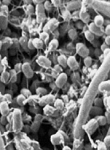|
|
|
EDITORIAL: How Next Generation Sequencing has Transformed Microbial Ecology
|
|
|
|
|
|
|
|
|
|

|
|
|
|
Jennifer Tsang, PhD
|
|
|
|
Harvard Medical School
|
|
Beth Israel Deaconess Medical Center, HMS, Boston, MA 02115, USA
|
|
jtsang@bidmc.harvard.edu
|
|
|
|
|
|
|
|
|
|

|
|
In recent years, biology has steadily become a more interdisciplinary field. Advances in technology have pioneered the development of many tools that allow concepts in physics, math, computer science, and chemistry to be applied to biological problems. As an example, next generation sequencing (NGS) technologies have been rapidly developed with these tools becoming more and more accessible to biologists. NGS is also known as high-throughput sequencing and is an all-inclusive term used to describe modern sequencing technologies including Illumina, 454, Ion torrent, and SOLiD sequencing that can generate billions of reads. With the advent of NGS and big data, many biological quandaries ranging from the microbiome to human population studies can now be explored in ways that were not previously possible.
|
|
|
|
|
|
|
|

|
|